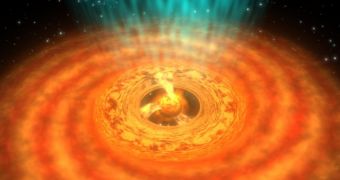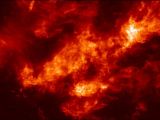Recent observations made by XMM-Newton reveal a strange formation process in baby star, defying astronomers' expectations. They show how streams of matter fall onto the young stars' magnetic atmospheres and radiate X-rays.
So far, the generally accepted process of star formation involved dense parts of molecular clouds collapsing into a ball of plasma to form a star. But after looking at nearly two hundred stars under formation, XMM-Newton contradicts the old theory and shows that streams of the falling matter interact with the hot corona of the star and cool it down, while the gas streams that are ejected heat up in shocks during the ejection process.
The new pictures prove that magnetic fields play a dramatic part in the process of star formation. "Star formation is a battle between gravity and everything else," says Manuel Guedel, Paul Scherrer Institut, Villigen, Switzerland, who leads a large project addressing magnetic activity in young stars within the constellation of Taurus.
The process of matter aggregating around a star is complex and can follow one of three different paths. It can accumulate in the star through magnetic funnels, it can gather in the disc around the star and give birth to planets, or it's thrown clear of the system in a wind or jet created by the overall magnetic field.
The Taurus Molecular Cloud was used as an observation target, being one of the nearest star nurseries and containing over 400 young stars. The observations showed that accretion - the growth of a massive object by gravitationally attracting more matter - is a widespread process among young stars, and it's responsible for producing excessive amounts of UV radiation in the star, that XMM-Newton's Optical Monitor detected.
The confusing part is that the same shock waves that caused the emission of the ultraviolet excess did not also produce an excess of X-rays, like astronomers expected. "We have not seen the expected X-rays that the shocks should produce on the surface of some stars," says Guedel.
Instead, the monitor detected a new and more subtle feature that suggests a cooling of the hot X-ray emitting atmosphere of the stars produced by the falling material. Besides cooling it, the gas streams falling onto the star were so dense that they absorbed most of the X-rays that the star's atmosphere had emitted.
The observations give astronomers new clues about the enormous forces involved in the star formation process.

 14 DAY TRIAL //
14 DAY TRIAL // 
